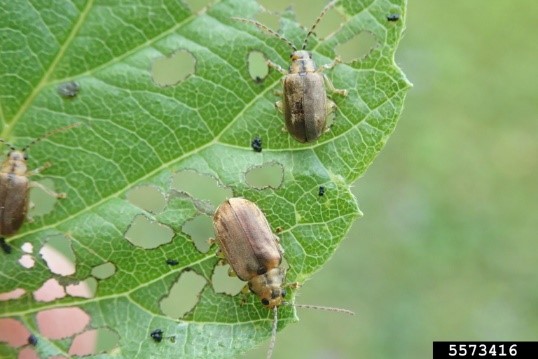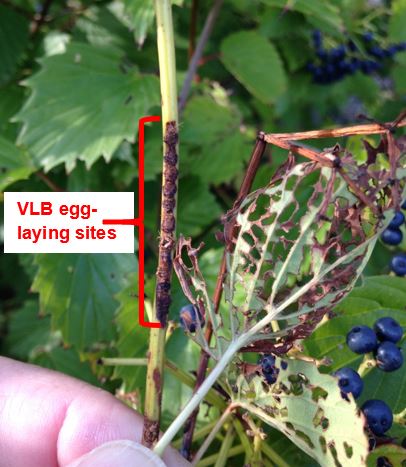What’s eating my viburnums and how can I stop it?
The invasive viburnum leaf beetle and larvae have been noticed devouring shrubs in Michigan.

Local viburnum leaf beetle activity
Between the 2019 and 2020 growing seasons, several residents in Livingston County contacted the local MSU Extension office with descriptions of leaf-feeding damage to viburnum shrubs. Some of them brought samples or sent a photograph. In each case, the leaf damage appeared to be caused by an invasive insect called the viburnum leaf beetle, Pyrrhalta viburni. In early June 2019, one client arriving with a sample of holey leaves and live viburnum leaf beetle larvae, said the larvae had “devoured all the leaves on my [arrowwood] viburnum last spring and are doing it again this year.”
This is a good example of the intensive defoliation that can be caused by viburnum leaf beetle (VLB). Volunteers at the MSU Extension statewide lawn and garden hotline (1-888-678-3464) also received many calls about VLB damage in June 2019. That July, a Livingston County client brought in a viburnum sample that appeared to have bumpy masses on the twigs indicating that VLB adults had laid eggs.
Now in 2020, the viburnum leaf beetle larvae are back again. If you have any viburnum shrubs now is a good time to look for feeding damage that may vary from a small patch of stripped leaves to what one client reported: “they destroyed 21 plants this past week [in late May].”
The pest
Viburnum leaf beetle, native to Europe, was first reported in Michigan in 2008. It has now been found in many locations in the southern half of the lower peninsula of Michigan and is expected to spread across the entire state.
Reviewing an article from Weston et al. 2007, one learns that viburnum leaf beetle is an insect species that only feeds on the leaves of shrubs in the genus Viburnum. It seems to find some species and cultivars of viburnum to be “tastier” than others. It is a double threat for its preferred shrub as both the larvae and adult beetles feed on the leaves. The larvae may defoliate the plant at the beginning of the season, then the adult beetles may defoliate the plant during the second half of the growing season. With so much leaf damage throughout the growing season, there is not much time for the plant to recover and build up nutrients for future growth. Consecutive years of defoliation can cause significant dieback and eventually kill plants.
The Cornell University Viburnum leaf beetle website is a very useful resource and provides a timeline of the life stages of this beetle pest, which can help with identification and management. Some of the basic management strategies listed by this website are described below. The Cornell University Department of Horticulture has taken leadership on researching and describing this insect pest in the United States.
Starting in late April, the younger greenish-yellow VLB larvae feed gregariously on the underside of tender, newly expanding viburnum leaves, skeletonizing the foliage. Damage usually starts on lower leaves with only the midribs and major veins left intact.
As the larvae mature, they grow to about one-third of an inch long, darken and develop a series of dark spots. These larger larvae are more likely to be found feeding on the tops of leaves. Adults will start feeding on the leaves in July and are active until frost.

What to do about viburnum leaf beetle
Choose resistant varieties and scout susceptible ones. Start by knowing the host. As mentioned, certain species and cultivars of viburnum are more susceptible to VLB damage than others. Cornell University has been maintaining a list of the most resistant and susceptible varieties to VLB damage, most recently updated in March 2018. The extremes are mentioned below. If you are going to choose a new viburnum bush to plant in your landscape, choose one of the most resistant varieties. If you already have one of the more susceptible varieties in your landscape, pay special attention to it and keep an eye out for injury caused by this pest.
Preferred hosts for VLB, i.e. shrub varieties most susceptible to infestations:
- Viburnum dentatum complex (arrowwood viburnums)
- V. nudum (possum-haw, smooth witherod viburnum)
- V. opulus (European cranberrybush viburnum)
- V. opulus var. americana (formerly V. trilobum) (American cranberrybush viburnum)
- V. propinquum* (Chinese viburnum, Taiwanese viburnum)
- V. rafinesquianum (Rafinesque viburnum)
Resistant hosts:
- V. bodnantense (dawn viburnum)
- V. carlesii (Koreanspice viburnum)
- V. davidii* (David viburnum)
- V. x juddii (Judd viburnum)
- V. plicatum (doublefile viburnum)
- V. plicatum var. tomentosum (doublefile viburnum)
- V. rhytidophyllum (leatherleaf viburnum)
- V. setigerum (tea viburnum)
- V. sieboldii (Siebold viburnum)
*Based on observations at the Van Dusen Botanical Garden, Vancouver, B.C. by Carolyn Jones
Prune out twigs with egg-laying sites. Removing the egg-laden twigs between early October and mid-April can be very successful in reducing the VLB population in your landscape.

Support beneficial predatory insects. Lady beetles, lacewings and spined soldier bugs, in different stages, eat viburnum leaf beetle larvae and adults. You can support these predators’ populations with diverse landscape plantings, for habitat. Also know that certain types of pesticides (e.g. broad-spectrum insecticides) are more detrimental for these beneficial insects than others.
Insecticide choices. Insecticidal soaps, spinosad, or chlorantraniliprole (Acelepryn) can help control the VLB pest with reduced harm to beneficial insects. These pesticides work best when applied to larvae early in the life cycle, likely in late April or early May. Spinosad and chlorantraniliprole also control adult viburnum leaf beetles.
Products containing carbaryl (Sevin) as the active ingredient or one of the pyrethroid insecticides (cyfluthrin, permethrin, resmethrin) are highly effective as foliar sprays, though also more toxic to other insects. Honey bees and other pollinators can be protected by spraying before flower buds open or by waiting until the petals fall. Soil-applied systemic products that contain imidacloprid are also effective but should also be applied after the flowers are gone to protect bees. Based on research by Cornell University, mentioned in a 2007 article by Paul Weston and others, a soil drench with an imidacloprid-based product can provide VLB control for at least two years.
Only spray infested viburnum plants and try to avoid drift onto other plants to preserve pollinators and other beneficial insects in the yard and garden.
More detailed information on viburnum leaf beetle is available at the Cornell University Viburnum Leaf Beetle website.
Selected reference:
- Weston, P.A., G. Desurmont, and E.R. Hoebeke. 2007. Viburnum Leaf Beetle (Coleoptera: Chrysomelidae): Biology, Invasion History in North America, and Management Options. Am. Entomol. 53 (2): 96-101.



 Print
Print Email
Email

